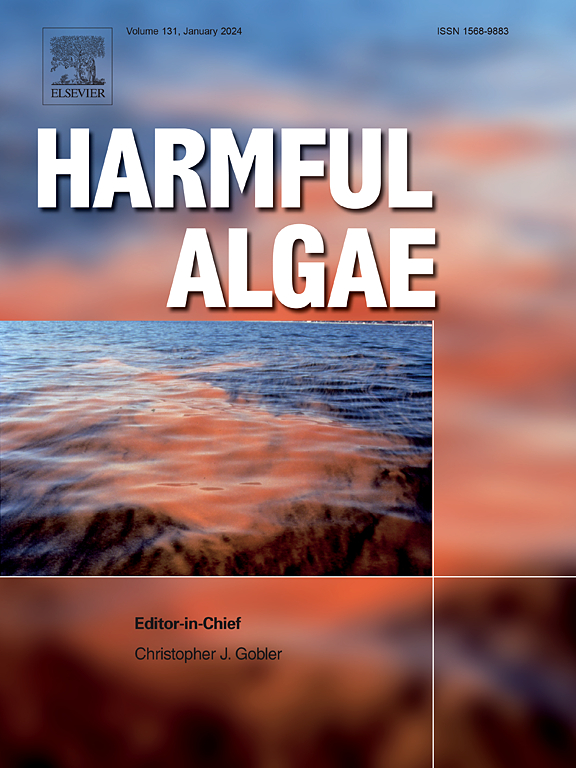微囊藻对有害蓝藻的生长抑制:基于转录组的相互作用分析
IF 4.5
1区 生物学
Q1 MARINE & FRESHWATER BIOLOGY
引用次数: 0
摘要
蓝藻华的发生和崩溃,特别是由微囊藻引起的蓝藻华,受到与各种微生物相互作用的影响。近年来的研究表明,微囊藻不仅受到异养细菌的影响,而且还与花青菌相互作用。本研究通过转录组分析研究了微囊藻是如何以及在什么条件下影响微囊藻生长的,并提出了这些相互作用的潜在机制。细藻A950对铜绿微囊藻KW在高温下的生长有较强的抑制作用。在共培养实验中,M. aeruginosa KW下调光合作用相关基因,包括psaC和psaE,从而损害能量产生和光收集。磷酸吸收基因如phoU和pstA的表达减少,表明M. aeruginosa KW与C. gracile A950相比在营养吸收方面处于劣势。与此相反,C. gracile A950在共培养2 h内迅速上调光合相关基因和ATP合酶基因,使其在早期竞争中获得了优于M. aeruginosa KW的优势。这些结果表明,C. gracile A950对M. aeruginosa KW的抑制作用主要是由于两种植物间光合相关基因的不平衡表达变化。本文章由计算机程序翻译,如有差异,请以英文原文为准。

Growth inhibition of harmful cyanobacterium Microcystis by picocyanobacterium Cyanobium: transcriptome-based interaction analysis
The occurrence and collapse of cyanobacterial blooms, particularly those caused by Microcystis, are influenced by interactions with a variety of microorganisms. Recent studies have revealed that Microcystis is affected not only by heterotrophic bacteria but also by interactions with picocyanobacteria. This study investigated how and under what conditions the picocyanobacterium Cyanobium impacts Microcystis growth, suggesting potential mechanisms of these interactions based on transcriptome analysis. Cyanobium gracile A950 exhibited a stronger inhibitory effect on the growth of Microcystis aeruginosa KW at higher temperature. In a co-culture experiment, M. aeruginosa KW downregulated photosynthesis-related genes, including psaC and psaE, which impaired energy production and light harvesting. Reduced expression of phosphate uptake genes, such as phoU and pstA, suggests that M. aeruginosa KW was disadvantaged in nutrient uptake compared to C. gracile A950. In contrast, C. gracile A950 rapidly upregulated photosynthesis-related and ATP synthase genes within 2 h of co-culture, allowing it to gain an early competitive advantage over M. aeruginosa KW. These findings indicate that the inhibitory effect of C. gracile A950 on M. aeruginosa KW was mainly due to the unbalanced expression changes in photosynthesis-related genes between the two species.
求助全文
通过发布文献求助,成功后即可免费获取论文全文。
去求助
来源期刊

Harmful Algae
生物-海洋与淡水生物学
CiteScore
12.50
自引率
15.20%
发文量
122
审稿时长
7.5 months
期刊介绍:
This journal provides a forum to promote knowledge of harmful microalgae and macroalgae, including cyanobacteria, as well as monitoring, management and control of these organisms.
 求助内容:
求助内容: 应助结果提醒方式:
应助结果提醒方式:


